Jade
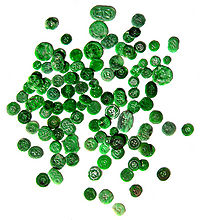
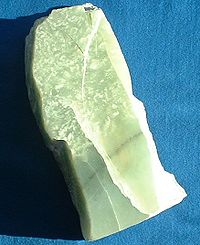
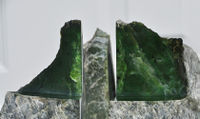
Jade is an ornamental stone. The term jade is applied to two different metamorphic rocks that are made up of different silicate minerals:
- Nephrite consists of a microcrystaline interlocking fibrous matrix of the calcium, magnesium-iron rich amphibole mineral series tremolite (calcium-magnesium)-ferroactinolite (calcium-magnesium-iron). The middle member of this series with an intermediate composition is called actinolite (the silky fibrous mineral form is one form of asbestos). The higher the iron content the greener the colour.
- Jadeite is a sodium- and aluminium-rich pyroxene. The gem form of the mineral is a microcrystaline interlocking crystal matrix.
Contents |
Etymology
The English word jade (alternative spelling "jaid") (as well as the English word "jadeite")is derived (via French l'ejade and Latin ilia[1]) from the Spanish term piedra de ijada (first recorded in 1565) or "loin stone", from its reputed efficacy in curing ailments of the loins and kidneys. Nephrite is derived from lapis nephriticus, the Latin version of the Spanish piedra de ijada.[2]
Overview
Nephrite versus jadeite
Nephrite and jadeite were used from prehistoric periods for hardstone carving. Jadeite has about the same hardness as quartz, while nephrite is somewhat softer. Both nephrite and jadeite are tough, but nephrite is tougher than jadeite. They can be delicately shaped. It was not until the 19th century that a French mineralogist determined that "jade" was in fact two different materials. The trade name jadite is sometimes applied to translucent or opaque green glass.
Among the earliest known jade artifacts excavated from prehistoric sites are simple ornaments with bead, button, and tubular shapes.[3] Additionally, jade was used for axe heads, knives, and other weapons. As metal-working technologies became available, the beauty of jade made it valuable for ornaments and decorative objects. Jadeite measures between 6.5 and 7.0 Mohs hardness, and Nephrite between 5.5 and 6.0,[4] so it can be worked with quartz or garnet sand, and polished with bamboo or even ground jade.
Unusual varieties
Nephrite can be found in a creamy white form (known in China as "mutton fat" jade) as well as in a variety of green colours, whereas jadeite shows more colour variations, including blue, lavender-mauve, pink, and emerald-green colours. Of the two, jadeite is rarer, documented in fewer than 12 places worldwide. Translucent emerald-green jadeite is the most prized variety, both today and historically. As "quetzal" jade, bright green jadeite from Guatemala was treasured by Mesoamerican cultures, and as "kingfisher" jade, vivid green rocks from Burma became the preferred stone of post-1800 Chinese imperial scholars and rulers. Burma (Myanmar) and Guatemala are the principal sources of modern gem jadeite, and Canada of modern lapidary nephrite. Nephrite jade was used mostly in pre-1800 China as well as in New Zealand, the Pacific Coast and Atlantic Coasts of North America, Neolithic Europe, and south-east Asia. In addition to Mesoamerica, jadeite was used by Neolithic Japanese and European cultures.
History
Prehistoric and historic China
During Neolithic times, the key known sources of nephrite jade in China for utilitarian and ceremonial jade items were the now depleted deposits in the Ningshao area in the Yangtze River Delta (Liangzhu culture 3400–2250 BC) and in an area of the Liaoning province and Inner Mongolia (Hongshan culture 4700–2200 BC).[5] As early as 6000 BC Dushan Jade was being mined. In the Yin Ruins of Shang Dynasty (1600 BC to 1050 BC) in Anyang, Dushan Jade ornaments was dug up in the tomb of the Shang kings. Jade was used to create many utilitarian and ceremonial objects, ranging from indoor decorative items to jade burial suits. Jade was considered the "imperial gem". From about the earliest Chinese dynasties until present, the jade deposits in most use were not only from the region of Khotan in the Western Chinese province of Xinjiang but also from other parts of China, such as Lantian, Shaanxi. There, white and greenish nephrite jade is found in small quarries and as pebbles and boulders in the rivers flowing from the Kuen-Lun mountain range eastward into the Takla-Makan desert area. River jade collection was concentrated in the Yarkand, the White Jades (Yurungkash) and Black Jade (Karakash) Rivers. From the Kingdom of Khotan, on the southern leg of the Silk Road, yearly tribute payments consisting of the most precious white jade were made to the Chinese Imperial court and there transformed into objets d'art by skilled artisans as jade was considered more valuable than gold or silver. Jade became a favorite material for the crafting of Chinese scholars objects, such as rests for calligraphy brushes, as well as the mouthpieces of some opium pipes, due to the belief that breathing through jade would bestow longevity upon smokers who used such a pipe.[6]
Jadeite, with its bright emerald-green, pink, lavender, orange and brown colours was imported from Burma to China only after about 1800. The vivid green variety became known as Feicui (翡翠) or Kingfisher (feathers) Jade. It quickly replaced nephrite as the imperial variety of jade.
In the history of the art of the Chinese empire, jade has had a special significance, comparable with that of gold and diamonds in the West.[7] Jade was used for the finest objects and cult figures, and for grave furnishings for high-ranking members of the imperial family.[7]
Prehistoric and historic India
The Jainist temple of Kolanpak in the Nalgonda district, Andhra Pradesh, India is home to a 5-foot (1.5 m) high sculpture of Mahavira that is carved entirely out of jade. It is the largest sculpture made from a single jade rock in the world.
Prehistoric and early historic Korea
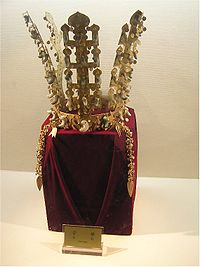
The use of jade and other greenstone was a long-term tradition in Korea (c. 850 BC – AD 668). Jade is found in small numbers of pit-houses and burials. The craft production of small comma-shaped and tubular "jades" using materials such as jade, microcline, jasper, etc., in southern Korea originates from the Middle Mumun Pottery Period (c. 850–550 BC).[8] Comma-shaped jades are found on some of the gold crowns of Silla royalty (c. AD 300/400–668) and sumptuous elite burials of the Korean Three Kingdoms. After the state of Silla united the Korean Peninsula in AD 668, the widespread popularisation of death rituals related to Buddhism resulted in the decline of the use of jade in burials as prestige mortuary goods.
Māori
Nephrite jade in New Zealand is known as pounamu in the Māori language (often called "greenstone" in New Zealand English) which plays an important role in Māori culture. It is considered a taonga, or treasure, and therefore protected under the Treaty of Waitangi, and the exploitation of it is restricted and closely monitored. It is found only in the South Island of New Zealand, known as Te Wai Pounamu in Māori—"The [land of] Greenstone Water", or Te Wahi Pounamu—"The Place of Greenstone".
Tools, weapons and ornaments were made of it; in particular adzes, the 'mere' (short club), and the Hei-tiki (neck pendant). These were believed to have their own mana, handed down as valuable heirlooms, and often given as gifts to seal important agreements. Nephrite jewellery of Maori design is widely popular with locals and tourists, although some of the jade used for these is now imported from British Columbia and elsewhere.[9]
Mesoamerica

Jade was a rare and valued material in pre-Columbian Mesoamerica. The only source from which the various indigenous cultures, such as the Olmec and Maya, could obtain jade was located in the Motagua River valley in Guatemala. Jade was largely an elite good, and was usually carved in a variety ways, whether serving as a medium upon which hieroglyphs were inscribed, or shaped into symbolic figurines. Generally, the material was highly symbolic, and it was often employed in the performance of ideological practices and rituals.
Faux jade
Many minerals are sold as jade. Some of these are: serpentine (also bowenite), carnelian, aventurine quartz, glass, grossularite, Vesuvianite, soapstone (and other steatites such as shoushan stone) and recently, Australian chrysoprase. "Suzhou jade," "Styrian jade," "Olive jade", and "New jade" are all really serpentine; "Transvaal jade" or "African jade" is grossularite; "Peace jade" is a mixture of serpentine, stichtite, and quartz; "Mountain jade" is dyed dolomite marble.
Faux jades are sold to the public as inexpensive jewelry or beads, whereas nephrite and jadeite are sold at fine jewelers for considerably higher prices. Reputable merchants can provide the scientific name of specific "jade" stones upon request, although clerks who sell faux jades may be unaware that multiple types of stone are sold under that name.
Confusion in Chinese and Korean about jade as opposed to other precious stones
In almost all dictionaries, the Chinese character yù (玉) is translated into English as "jade". However, this frequently leads to misunderstanding: Chinese, Koreans, and Westerners alike generally fail to appreciate that the cultural concept of jade is considerably broader in China and Korea than in the West. A more accurate translation for this character on its own would be "precious/ornamental rock". It is seldom if ever used on its own to denote "true" jade in Mandarin Chinese; for example, one would normally refer to ying yu (硬玉, "hard jade") for jadeite, or ruan yu (軟玉, "soft jade") for nephrite. The Chinese names for many ornamental non-jade rocks also incorporate the character yù, and it is widely understood by native speakers that such stones are not, in fact, true precious nephrite or jadeite. Even so, for commercial reasons, the names of such stones may well still be translated into English as "jade", and this practice continues to confuse the unwary.
Enhancement
Jade may be enhanced (sometimes called "stabilized"). Note that some merchants will refer to these as Grades, but it is important to bear in mind that degree of enhancement is different from colour and texture quality. In other words, Type A jadeite is not enhanced but can have poor colour and texture. There are three main methods of enhancement, sometimes referred to as the ABC Treatment System:
- Type A jadeite has not been treated in any way except surface waxing.
- Type B treatment involves exposing a promising but stained piece of jadeite to chemical bleaches and/or acids and impregnating it with a clear polymer resin. This results in a significant improvement of transparency and colour of the material. Currently, infrared spectroscopy is the most accurate test for the detection of polymer in jadeite.
- Type C jade has been artificially stained or dyed. The red colour of Red jade can be enhanced with heat. The effects are somewhat uncontrollable and may result in a dull brown. In any case, translucency is usually lost.
- B+C jade is a combination of B and C: it has been both artificially dyed AND impregnated.
- Type D jade refers to a composite stone such as a doublet comprising a jade top with a plastic backing.[10]
Gallery of Chinese jades
 Jade dragon ring, Shang Dynasty (1700–1150 BC) |
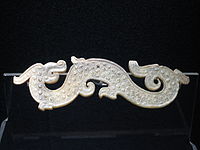 Jade dragon, Warring States (403–221 BC) |
 A jade Bi with dragons, Warring States (403–221 BC) |
 Jade coiled serpent, Han Dynasty (202 BC –220 AD) |
.jpg) Jade dragon, Tang Dynasty (618–907 AD) |
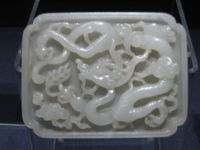 Belt plaque with dragon, Yuan Dynasty (1279–1368 AD) |
 Belt plaque with dragon, Ming Dynasty (1368–1644 AD) |
See also
- Jade burial suit
- Mumun Pottery Period, the time in Korea when jade ornament production began
- Heavenly Horse Tomb, a Silla royal tomb in Korea with jade artifacts.
- Pounamu
Notes
- ↑ http://www.etymonline.com/index.php?term=jade
- ↑ Easby, Elizabeth Kennedy. Pre-Colombian Jade from Costa Rica. (1968). André Emmerich Inc., New York
- ↑ Liu, Li. The Products of Minds as Well as Hands: Production of Prestige Goods in Neolithic and Early State Periods of China. Asian Perspectives 42(1):1-40, 2003, pg 2.
- ↑ http://www.orionsgemz.com/Mohs.html Orionsgemz.com Retrieved on 06-01-07
- ↑ Liu, Li 2003:3-15
- ↑ Martin, Steven. The Art of Opium Antiques. Silkworm Books, Chiang Mai, 2007
- ↑ 7.0 7.1 Jade. Gemstone.org
- ↑ Bale, Martin T. and Ko, Min-jung. Craft Production and Social Change in Mumun Pottery Period Korea. Asian Perspectives 45(2):159-187, 2006.
- ↑ Salt, Donn, 1992, Stone, Bone and Jade - 24 New Zealand Artists, David Bateman Ltd, Auckland.
- ↑ http://www.ssef-alumni.org/pdf/newsletter_3.pdf
References
- Scott-Clark, Cathy and Levy, Adrian. (2002) The Stone of Heaven: Unearthing the Secret History of Imperial Green Jade. ISBN 0316525960
Further reading
- Laufer, Berthold, 1912, Jade: A Study in Chinese Archeology & Religion, Reprint: Dover Publications, New York. 1974.
- Rawson, Jessica, 1975, Chinese Jade Throughout the Ages, London: Albert Saifer, ISBN 0-87556-754-1
- Jadeite sources in Mesoamerica (PDF)
- Between hell and the Stone of Heaven: Observer article on Jade Mining in Burma
- Old Chinese Jades: Real or Fake?
- BOOK REVIEW, The Stone of Heaven: The Secret History of Imperial Green Jade by Adrian Levy and Cathy Scott-Clark
External links
- The British Museum - 7,000 years of Chinese jade
- Gravity Measurement For Testing Jade
- Jade: Chinese Stone of Heaven
- mindat.org (Mineralogical data about Jade)
- Jade in Canada
- "Jade in British Columbia table", BC Govt MINFILE summary of jade showings and producers
- "Guatemalan Jadeite", Precolumbian Replicas and Fine Jewelry
|
|||||||||||||||||||||||||||||||||||||||
